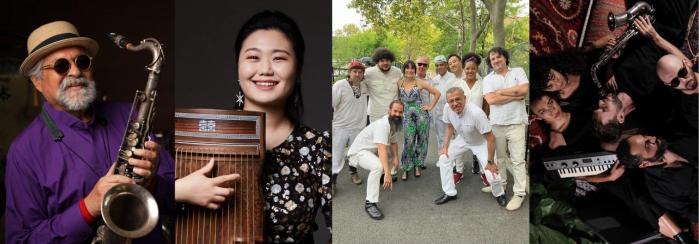BY STEPHEN WOLF
Lowe’s lecture charts cultural current set in motion
Few of us back in grad school could tolerate Henry James. His tedious, twisting sentences were too long and filled with many commas and compound-complex phrases within each other — and his sluggish, complicated characters certainly didn’t seem like New York. Not when we’re strolling over to Ginsberg’s on East 7th or spotting James Baldwin or Cummings in the Village. That was New York: The Stork Club and Scott Fitzgerald, Whitman and Langston Hughes, Holden in a cheap hotel and anything about the Brooklyn Bridge. Certainly Henry James was not New York. But of course he was, and both his work and some of that world are among us every day.
At 6:30pm on February 3, the eminent author and lecturer David Garrard Lowe is speaking at the glorious Church of the Ascension, at Fifth Avenue and 11th Street. Lowe is a brilliant New York architectural historian, and his lectures are as richly rendered as his books. He is the author of, among others, “Beaux Arts New York” and “Art Deco New York.” Lowe’s book “Stanford White’s New York” was the favorite of its editor, Jackie Kennedy Onassis.
The event is co-sponsored by the Beaux Arts Alliance, of which Lowe is the president. A New York organization that “celebrates the cultural links between the United States and France,” the Alliance proudly boasts that it “found New York a city of sooty brownstone and left it one of bright marble, furnished it with palaces and galleries, caravansaries and public monuments.”
“It was the Beaux Arts style,” Lowe declared, “that made New York dare to be extravagant and also to be beautiful.” Dedicated to celebrating French creations, the wit of Molière, elegant boulevards and Burgundy wine, the Alliance also is concerned about the “cultural current set in motion by American writers like Henry James” — who is the topic of Lowe’s lecture, “Henry James: A Child of the Village.”
Henry James is one of those rare writers claimed by both the United States (he was born in New York City in 1843) and England — to which he claimed citizenship in 1915 owing to the reluctance of the U.S. to enter The Great War.
In the advertisement for Lowe’s approaching lecture, one of James’s works, cited from his many volumes of writing (24 volumes when issued in 1918), is “Washington Square.” The novel — at 198 pages, short compared to most of his other novels — is set in a Greenwich Village of the 1840s, 40 years earlier than the time James wrote it. The central character is Catherine Sloper — the dull, unattractive daughter of a renowned physician. At a party, Catherine meets Morris Townsend and is enthralled by him. Catherine’s father disapproves of the relationship. Believing that Townsend only courts his daughter for his money, he declares he will leave nothing in his will for Catherine if she insists on marrying Townsend. Catherine breaks with her father, but Townsend rejects Catherine when she tells him of her father’s ultimatum. Despite two other offers of marriage during her lifetime, Catherine becomes that antiquated vision of an unmarried woman: a spinster. Fearing the return of Townsend, when the doctor dies, he leaves his daughter but a small piece of his fortune. The story ends with Catherine, lonely and aged, sitting in a parlour with her knitting “for life, as it were.”
James was born into a wealthy, prominent and educated family residing at 21 Washington Square, perhaps the city’s most elegant neighborhood of its day. Soon afterwards the family moved to 11 Fifth Avenue and, in 1848, to 58 West 14th Street. It was this home that “became to me,” wrote James, “for ever so long afterwards a sort of anchorage of the spirit,” and though traveling through much of Europe in his youth (then educated in Newport before entering Harvard to study law), his world of New York was generally confined — save for a few pleasant visits to the new Central Park — from 14th Street and Fifth Avenue down to his grandmother’s house along Washington Square.
The home of Doctor Sloper was actually the home of James’s grandmother. This small section of the city (14th down Fifth Avenue to Washington Square) had a refined, established, prosperous air. It provided a sort of buffer to the crowded, miasmic ghettos far downtown.
When James writes of New York at this time, he states it is “small, warm, dusky” and, ideally, “homogenous.” But James was born into a New York undergoing enormous and rapid change. At the time of his birth the city’s population was 391,114 — but with the arrival of many thousands of Irish fleeing starvation and Germans escaping political repression, the city swelled to almost two million when “Washington Square” was published in 1881.
And James was horrified.
He despised the destruction of so much of the city in its ramped expansion Uptown. The demolition of the home where he was born had the effect, James wrote, “of having amputated half of my history.” But he especially loathed the unending swarm of filthy immigrants who turned New York into what he called a “terrible town” with its horrid discord of accents, their lack of good manners, the “denizens of the New York Ghetto, heaped as thick as the splinters on the table of a glass-blower,” how the tenement fire escapes had become “perches and swings for human squirrels and monkeys,” and the city itself was festering with “the swarming…ant-like population [that] darted to and fro.”
That James hated what New York had become perhaps explains why he set “Washington Square” 40 years earlier than when he wrote it — back to the time of his birth, before the surging waves of untidy, often uneducated immigrants, before the destruction of so much of the city’s glorious architecture, before the loss of his own youth. Though he had tried capturing a portion of his beautiful, irretrievable past, perhaps he realized he had failed to do so (which may explain why he omitted “Washington Square” from a collection of his New York stories).
Whatever David Garrard Lowe speaks to us about on the evening of February 3 will be enlightening. He lectures widely in the U.S. and Europe. At New York’s Metropolitan Museum of Art, he is its most popular lecturer, selling out audiences — weekly — of over 500 people.
His lecture will conclude with commentary on the renovation of the Church of the Ascension, where the event is held. The first church ever built on Fifth Avenue, it was consecrated in November 1841 just prior to the time in which James’s “Washington Square” is set. Some of New York’s richest and most powerful citizens once sat in its rented pews, August Belmont and William B. Astor among them. When poet and Revered Percy Stickney Grant was appointed as rector in 1893, he would accept the position only if use of the pews was free. The church agreed though strongly encouraged voluntary donations.
The New York writing of Henry James, like the stately architecture created then, preserves a portion of some of New York’s most elegant and refined times. No one will present to us this time and that work better than David Garrard Lowe.


































